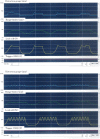Lumbar mechanical traction: a biomechanical assessment of change at the lumbar spine
- PMID: 30961554
- PMCID: PMC6454715
- DOI: 10.1186/s12891-019-2545-9
Lumbar mechanical traction: a biomechanical assessment of change at the lumbar spine
Abstract
Background: Lumbar traction is a traditional treatment modality for chronic low back pain (CLBP) in many countries. However, its effectiveness has not been demonstrated in clinical practice because of the following: (1) the lack of in vivo biomechanical confirmation of the mechanism of lumbar traction that occurs at the lumbar spine; (2) the lack of a precise delivery system for traction force and, subsequently, the lack of reproducibility; and (3) few randomized controlled trials proving its effectiveness and utility.
Methods: This study was planned as a preparatory experiment for a randomized clinical trial, and it aimed (1) to examine the biomechanical change at the lumbar area under lumbar traction and confirm its reproducibility and accuracy as a mechanical intervention, and (2) to reconfirm our clinical impression of the immediate effect of lumbar traction. One hundred thirty-three patients with non-specific CLBP were recruited from 28 orthopaedic clinics to undergo a biomechanical experiment and to assess and determine traction conditions for the next clinical trial. We used two types of traction devices, which are commercially available, and incorporated other measuring tools, such as an infrared range-finder and large extension strain gauge. The finite element method was used to analyze the real data of pelvic girdle movement at the lumbar spine level. Self-report assessments with representative two conditions were analyzed according to the qualitative coding method.
Results: Thirty-eight participants provided available biomechanical data. We could not measure directly what happened in the body, but we confirmed that the distraction force lineally correlated with the movement of traction unit at the pelvic girdle. After applying vibration force to preloading, the strain gauge showed proportional vibration of the shifting distance without a phase lag qualitatively. FEM simulation provided at least 3.0-mm shifting distance at the lumbar spine under 100 mm of body traction. Ninety-five participants provided a treatment diary and were classified as no pain, improved, unchanged, and worsened. Approximately 83.2% of participants reported a positive response.
Conclusion: Lumbar traction can provide a distractive force at the lumbar spine, and patients who experience the application of such force show an immediate response after traction.
Trial registration: University Hospital Medical Information Network - Clinical Trial Registration: UMIN-CTR000024329 (October 13, 2016).
Keywords: Biomechanical experiment; Chronic low back pain; Finite element method; Lumbar traction; Traction conditions; Traction stiffness.
Conflict of interest statement
Ethics approval and consent to participate
All procedures performed in studies involving human participants were conducted in accordance with the ethical standards of the institutional and/or national research regulations, and with the 1964 Helsinki declaration and its later amendments or comparable ethical standards. Written informed consent was obtained from all participants, and the study protocol was approved by the institutional review board of the Japanese Clinical Orthopaedic Association (approval number: 2015–01).
Consent for publication
Not applicable.
Competing interests
The funding body or device providers had no role in the study design, data collection, data analysis, data interpretation, or writing of the manuscript.
Publisher’s Note
Springer Nature remains neutral with regard to jurisdictional claims in published maps and institutional affiliations.
Figures






References
-
- Ono R, Yamazaki S, Takegami M, Suzukamo Y, Konno S, Kikuchi S, Fukuhara S. Patient-reported disability in the general Japanese population was associated with medical care visits for low back pain, regardless of pain intensity. J Orthop Sci. 2015;20(4):742–749. doi: 10.1007/s00776-015-0719-3. - DOI - PubMed
-
- Graphical Review of Japanese Household, from Comprehensive Survey of Living conditions. 2013. Available at: http://www.mhlw.go.jp/toukei/list/dl/20-21-h25.pdf Accessed June 29, 2018.
-
- Guzman J, Esmail R, Karjalainen K, Malmivaara A, Irvin E, Bombardier C. Multidisciplinary bio-psycho-social rehabilitation for chronic low back pain. Cochrane Database Syst Rev. 2002;1:CD000963. - PubMed
-
- Schimmel JJ, de Kleuver M, Horsting PP, Spruit M, Jacobs WC, van Limbeek J. No effect of traction in patients with low back pain: a single Centre, single blind, randomized controlled trial of intervertebral differential dynamics therapy. Eur Spine J. 2009;18(12):1843–1850. doi: 10.1007/s00586-009-1044-3. - DOI - PMC - PubMed
Publication types
MeSH terms
Grants and funding
LinkOut - more resources
Full Text Sources
Medical

